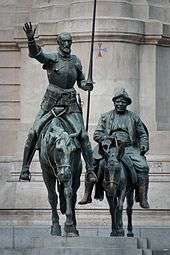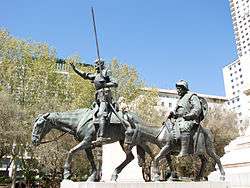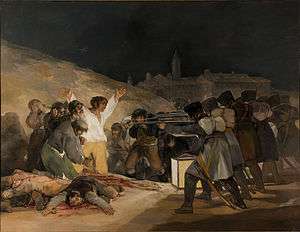Plaza de España, Madrid
 The Torre de Madrid (left), Cervantes Monument (center), and the Edificio España (right) | |
| Type | square |
|---|---|
| Maintained by | Ayuntamiento of Madrid |
| Location | Madrid, Spain |
| Coordinates | 40°25′22″N 3°42′43″W / 40.42278°N 3.71194°W |
Plaza de España (Spanish for Spain Square) is a large square, a popular tourist destination located in central Madrid, Spain at the western end of the Gran Vía. It features a monument to Miguel de Cervantes Saavedra and is adjacent to two of Madrid's most prominent skyscrapers. Additionally, the Palacio Real (Royal Palace) is only a short walk south from the plaza.
Cervantes Monument

Right in the center of the square is the monument to Miguel de Cervantes, a sculptural group that was made at the same time as the urbanization of the square itself. Around the monument, a series of landscaped spaces were created for the enjoyment and rest of the passers-by.
In front of the statue of Don Quixote and Sancho Panza, a pond of rectangular form is located that forms one of the most typical views of the Spanish capital, since just behind it see the buildings of Torre de Madrid and Edificio España. Initially, the statues of Don Quixote and Sancho Panza were located, approximately, in what is now the center of the pond, since it was later made. The constructive part of the monument is elaborated in granite, while the sculptural part was decided to be made in red stone from Sepúlveda (and some additions in bronze).
Its accomplishment was carried out on the occasion of the third centenary of the publication of the second part of Don Quixote, in 1915, and which continued with the centenary of the death of the writer (1616), in 1916. The author of the project was the architect and sculptor Rafael Martínez Zapatero, who counted on the collaboration of Pedro Muguruza Otaño. The sculptures added were the work of Lorenzo Coullaut Valera.
The figures that make up this emblematic monument have, on the one hand, a seated Cervantes and at the base of the monument, and under the feet of the writer, are the statues of Don Quixote and Sancho Panza. The set was finalized when the figures of Dulcinea and Aldonza Lorenzo were added, also characters of the Cervantes novel. Alluding to the universality of Don Quixote, the monument also contemplates the five continents, all of them reading the work of Cervantes. On the other side and above the fountains, is represented the Spanish Literature, dressed in period and holding a book with his right hand. The tree that predominates in the landscaping of the square is the olive tree, in homage to the La Mancha fields in the wanderings of Don Quixote and Sancho.
 Stone sculpture of Miguel de Cervantes
Stone sculpture of Miguel de Cervantes_02.jpg) North-eastern side of the Cervantes monument
North-eastern side of the Cervantes monument Bronze sculptures of Don Quixote and Sancho Panza
Bronze sculptures of Don Quixote and Sancho Panza Bronze sculptures of Don Quixote and Sancho Panza
Bronze sculptures of Don Quixote and Sancho Panza_06b.jpg) Stone sculpture of Aldonza Lorenzo
Stone sculpture of Aldonza Lorenzo Plaza de España, Madrid.
Plaza de España, Madrid.
Surrounding buildings
Adjacent to the plaza are two of the tallest buildings in Madrid, the 142 m (466 ft) Torre de Madrid ("Madrid Tower"), built in 1957 and the 117 m (384 ft) tall Edificio España ("Spain Building"), built in 1953.[1]
There, you will also find the House of Gallardo, built in 1911, considered one of the notable examples of the Art Nouveau style of architecture in the city.
Metro station
Plaza de España is also the name of a Metro station located on the eastern corner of the plaza, serviced by the #3 and #10 lines, with a connection to the #2 line.[2]
History

In 1808, the area was part of the Príncipe Pío hill. It was one of the locations used by French firing squads to execute prisoners taken during the May 2nd uprising.
Notes
- ↑ "Madrid Skyscraper Diagram". Skyscraper Source Media. Retrieved 14 January 2015.
- ↑ es:Plaza de España (Metro de Madrid)
References
- Madrid Skyscrapers at skyscraperpage.com
- Estación de Plaza de España / Noviciado from the Spanish-language Wikipedia article. Retrieved May 20, 2006.
- Plaza de España (Madrid) from the Spanish-language Wikipedia article. Retrieved May 20, 2006.
| Wikimedia Commons has media related to |
Coordinates: 40°25′25″N 3°42′44″W / 40.423485°N 3.712171°W